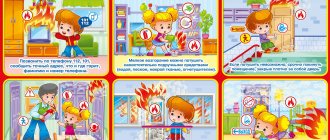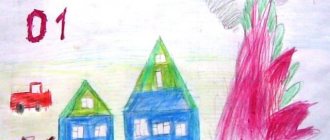Fire safety rules for children
Every year, children under fourteen years of age are killed or seriously injured in fires and fires. The main reason can be called the dishonesty of parents, as well as the lack of knowledge and skills to behave in case of fire. To prevent fire safety, it is necessary to conduct lessons, conversations, and lectures.
It is recommended to consolidate the result with the help of games that help update the information received. Cartoons developed with the support of the Fire Service will help explain fire safety rules to young children (“Fire in the forest”, “Fire in the apartment”, “Rules of behavior for children in case of fire”).
Fire safety rules will be explained during life safety lessons, as well as during class hours on this topic. The use of poems by S. Marshak “Very, very important rules!”, “Song of Matches”, A. Usachev “Fire”, E. Gladkova “If there is a fire in the house” and others will help in this.
Basic fire safety rules for children
- You cannot play with matches, lighters, or match-candles;
- You cannot set fire to dry leaves, dry grass, trees, or poplar fluff;
- You cannot play with fireworks, sparklers, or firecrackers without adult supervision;
- You cannot use gasoline, kerosene and other flammable materials for gaming purposes;
- Do not throw bottles of deodorants, perfumes, air fresheners, etc. into a fire or set fire to them. This may result in an explosion and immediate fire;
- You cannot make a fire or play with an open fire indoors;
- You cannot make a fire in wooden sheds, dilapidated buildings, basements and attics;
- if there is a need for light, it is better to use a flashlight than matches;
Security Prevention
Prevention and training of primary school students in fire safety rules must be carried out by adults in order to avoid an accident.
- Excursions
Usually, on Fire Safety Day in Russia, local branches of the Ministry of Emergency Situations are happy to invite their little guests on an excursion. Fire service employees themselves meet and introduce them to their profession. Firefighters using real equipment demonstrate its operation and explain its operation.
You can explore the building itself, look around the gym, classrooms and recreation room. Firefighters will even wear their gear at speed. Children will be able to ask questions that interest them, and city defenders will even talk about their working days and tell exciting stories.
Of course, the guys will learn not only about the work of firefighters, but also learn safety rules from the professionals themselves. Afterwards, children will be able to go to the museum, which is located at almost every department of the Ministry of Emergency Situations. There, schoolchildren will inspect equipment, clothing and technology.
Fire department museums often hold special courses that teach primary and secondary school students the correct behavior in a burning building, extinguishing small fires, and providing first aid to victims.
In the museum you can feel like a real fireman: employees will teach you how to unwind, use and rewind a fire hose, and tell you about the construction of a gas mask and fire extinguisher.
- At school
The school itself should regularly conduct fire drills. They will teach young schoolchildren to leave the building of an educational institution in an orderly manner, to react seriously to the sound of a siren or bell, and also to save children from unnecessary panic.
Teachers or those in charge should explain to young students the operation and purpose of the fire warning buttons.
These activities greatly reduce the likelihood that your child will fall behind the rest of the class or panic.
Rules for handling fire at home
For children, the main rule is not to play with fire without adult supervision. Thus, using and playing with electrical appliances (TV, microwave, computer), turning on a gas stove, lighting candles, playing with light bulbs and garlands are excluded.
Older children can be taught to use a stove and household appliances, but emphasize that if there is no great need for their use, it is better to wait for their parents. A mandatory requirement will be to disconnect all equipment from the power supply after use.
There is no need to turn your child against fire, but you should be as honest as possible about the consequences of fires.
Children are great inventors, thousands of ideas swarm in their heads, and if you do not warn in advance about the results of such dangerous pranks, it will be too late.
Parents must themselves protect their child from danger.
First of all, it is necessary to store all household chemicals out of the reach of children, all of them have a high degree of flammability. Also, children should not have free access to matches, lighters, candles, and electrical wires must be hidden under baseboards.
To test children's knowledge about fire safety rules, you need to conduct small tests or periodically ask them questions. For example:
- what to do if a fire starts? (call the rescue service 112/01, give your name and address);
- How to put out a fire that has just flared up? (thick blanket, wet blanket, fire extinguisher);
- How should you behave during a fire? (don’t panic, don’t hide, call for help).
Children should be told that smoke can be more dangerous than fire itself. And in order not to suffocate during a fire, you need to wet a rag or gauze and breathe through it. It is also necessary to go down to the floor, because the smoke concentration is lower there.
Extracurricular activities
Teachers at extracurricular activities in elementary schools can show students how to prevent accidents at home or school. It is much easier for children to remember all the warnings and rules while playing.
- Quizzes
The advantages of quizzes, questionnaires and riddles are that they are quite easy to create yourself, and you can come up with any design for them. You can cover different topics:
- fire safety rules in the apartment;
- rules for handling electrical appliances;
- how children should behave in case of fire;
- how to eliminate a fire indoors or outdoors;
- Forest fires;
- firefighter profession.
It will be especially interesting to present everything in an allegorical form. You can use images of your favorite cartoon characters. For example, “How Dunno Decided to Become a Fireman” or “The ABCs of Fire Safety,” where mischievous Smeshariki, Fixiki and other fairy-tale and cartoon characters will tell schoolchildren how to properly extinguish electrical fires and how to behave in a burning apartment.
The quiz can be designed as an interactive presentation: children will participate in the adventures of the heroes and answer questions asked by them or the teacher . You can supplement the game with riddles, music or cartoon footage. This option will definitely appeal to children and has many options for implementation.
There is another type of quiz design. Several students can participate in the performance by asking questions and riddles to their classmates. There are also many options for heroes and themes: you can play yourself (schoolchildren) or characters from fairy tales and cartoons (here you will need costumes or masks). You can supplement the quiz with a presentation and music.
A competitive form of quiz will help develop interest in the event. For the correct answer to a question or riddle, the student is given a token (can be made of cardboard) of any shape, for example, a fireman’s helmet or a fire extinguisher. And the winner will be awarded with a themed poster, a treat or a cardboard medal.
- Conversations
Conversations are the most informative form of event to provide knowledge of fire safety. A teacher or invited specialist will give a lecture on the rules of proper behavior with fire. Another advantage of this form of event is the opportunity for schoolchildren to ask questions that interest them.
The topic of the speech can be anything. It is better to start a conversation with younger schoolchildren with a short story about the development of firefighting in Russia, and then move on to the safety rules themselves in case of fire in a school, in an apartment or in the forest.
It is quite difficult for elementary school students to fully consolidate information received only from hearing. To make memorization easier, a teacher or specialist can prepare a presentation with illustrations and a summary of what was said. You can also use chalk and a blackboard, drawing and writing down what is needed.
Posters and drawings on paper will attract children's attention. To memorize the material, you can use educational films, cartoons and video materials that complement and reinforce the information told.
It will be very interesting for children if the structure of some things and rules are shown in real objects. Bringing a fireman's helmet, a fire extinguisher, building models - everything will attract the attention of younger schoolchildren, who will be able to better remember the material.
- Games
Perhaps games and sporting events are the most fun and interesting type of fire safety training event. They can be held on Russian Fire Service Day, celebrated on April 30.
At the sports festival, the presenter, together with a guest hero (a character from a cartoon fairy tale or a fireman), will test the agility, courage and speed of younger schoolchildren. The following competitions can be held:
- “fire truck relay”: participants take turns getting on small cars or scooters, then speeding to the turn, and then returning to the others. The first team to complete the challenge wins;
- “pet rescue”: a relay race that includes several types of obstacles (tunnel, bumps, mat), after overcoming which the participant must take a toy animal and return to the team;
- “put out the fire” competition: this test tests the accuracy and dexterity of schoolchildren. While sitting and standing, participants take turns throwing balls (water droplets or sandbags) into the fire basket. The team that hits the most times wins;
- “firefighter call”: team members will have to get through obstacles (hoops, bumps, skittles), then run to the phone and shout “01 – FIRE!” and pass the baton;
- “pass the sandbags”: the teams line up. First, the ball (“sandbag”) is passed between the hands and then under the feet.
After competitions and competitions, you can arrange a display of chants and team mottos. Then – summing up and awarding the winners.
- Creative exhibitions
Primary school children can be introduced to fire safety rules through creativity. The teacher will offer to do any craft that explains the danger of fire.
It could be a poster, a drawing, a craft made from natural and available materials, embroidery, a toy, a cardboard house, a car, a tree, etc. You can create a themed crossword puzzle. Students will be interested in getting acquainted with the exhibits of the organized exhibition.
Rules for handling fire in the forest
In most cases, the cause of forest fires is the carelessness and carelessness of people.
- You cannot make a fire in places with dry grass, under tree crowns, or in peat bogs. The place for the fire must be carefully selected, cleared of flammable material, and the fire itself must be lit in a specially dug earthen hole.
- It is not allowed to leave and leave the fire unextinguished or smoldering. It can be filled with water or covered with sand.
- You should not make a fire in dry and windy weather.
- Do not leave paper, plastic utensils or glass items at the resting place. The latter are very dangerous because the sun's rays are focused on the glass, which can result in a forest fire.
- Spontaneously combustible materials should not be left in the forest.
- You cannot use pyrotechnics in the forest.
Rules for children's behavior in case of fire
If there are no adults near the child during a fire, he will have to make his own decisions and act confidently. To do this, parents or teachers must teach him the chain of actions in case of fire.
- Call 01/112 and report your location and emergency situation.
- Ask your neighbors for help and tell them about the fire.
- Do not hide in hard-to-reach places; rescuers simply will not be able to come to the rescue or find the victim.
- Do not use the elevator during a fire. Go down stairs only.
- Follow all instructions from firefighters and rescuers who arrived at the scene.






